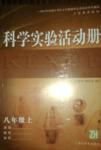
 科学实验活动册系列答案
科学实验活动册系列答案科目:高中英语 来源:2004全国各省市高考模拟试题汇编(天利38套)·英语 题型:050
阅读理解
阅读下面短文,从每题所给的四个选项(A、B、C和D)中,选出最佳选项。
Most offences (犯罪行为), particularly break - ins, assaults (袭击) and hit - and - run car incidents leave traces such as broken glass, blood, fibres or hairs. All these can be left at the scene of offences, moved to a victim (受害者), carried away by the offender or exchanged when cars knock into each other. Legal medical experts are taught during their training that “every contact leaves a trace,” meaning that the criminal leaves something at the scene of crime. The first stage of any investigation, therefore, is careful examination of the scene and the collection of anything useful found there.
Today's well - equipped lab can help the police use everything they find in their investigation. Taking finger - prints, for example, is still one of the most well - known methods used by the police. However, this matching of fingerprints has been revolutionized by computers. A larger number of fingerprints can now be studied withina much shorter time. The use of various types of radiation makes it possible that even fingerprints left on human skin can now be recognized.
The smallest bit of a man's skin, hair or blood left at the scene of a crime can also be matched to an offender with certainty by using a technique called DNA profiling or finger printing. DNA is a substance present in every cell of the body; and everyone (except twins ) has a special DNA profile. A certain DNA profile can be studied and compared with the DNA profile such as blood, found at the scene of a crime. Careful study of traces left at the scene of a crime is now possible with the electronic microscope. In theory, there are limits to the use of science in law cases. This is encouraging because the forensic pathologists (法医病理学家) say that the most powerful deterrent (威慑) to crimes is not so much the fear of punishment as the certainty of discovery.
1.Which of the following is NOT true according to the passage?
[ ]
A.When a car accident takes place, traces of the offending car will be either left in one of the cars or both.
B.In order to collect evidence (证据), the police must investigate the scene of a crime.
C.The theory “every contact leaves a trace” is taught to cheer up the police to carry on different investigations.
D.It is very important to keep the scene of a crime as it was when the crime took place.
2.The computer helps to ________.
[ ]
A.study a fingerprint on human skin
B.study or examine bigger fingerprints
C.store more fingerprints
D.match a large number of fingerprints in a much shorter period of time
3.The evidence of the DNA profiles is accepted by the judges because ________.
[ ]
A.DNA profile are different from one another (except twins)
B.even twins have different DNA profile
C.it's easy to find the DNA profile at the scene of crime
D.it's impossible to destroy the DNA profile once it is left
4.Which of the following could be used as the best title for this passage?
[ ]
A.The Importance of the Fingerprint Study
B.Crimes and Their Traces
C.The Science of the Investigation of a Crime
D.The Development of Forensic Science
查看答案和解析>>
科目:高中英语 来源:学习·探究·诊断 高二英语(下) 题型:050
阅读理解
Tens of Thousands of couples across the United States are racing to get marred by April 30. This is the result of a new law that makes illegal(非法的) immigrants(移民) legal if they marry by then.
The law has sent marriage rising by 50 percent to 300 this year in immigrant-rich Los Angeles, Houston and New York. The new law, passed in the last days of the Clinton administration(任期), contains a large number of measures to help immigrants and their loved ones become legal.
Critics say it also brings many marriage fraud(诈骗). A key aspect allows immigrants to look for houses while remaining in the USA-if they are married to a citizen or legal resident and hand in applications by April 30After the date, applicants will have to return to their native countries to deal with their paperwork-a requirement that could take as long as 10 years.
Demand for marriage licenses in Manhattan this year jumped from 100 a day to more than 300. The Los Angeles County registrar(户籍员)-recorder's office supplied 12,997 marriage license during January and February, a 59 percent increase over last year.
Critics say the new law encourages false marriage. There are a lot of marriage frauds as people rush to make use of this window. In the past cases citizens or legal residents were paid US 10,000 or more to marry illegal immigrants in which immigration is concluded may be investigated for as long as two years after the vows.
“It's not worth the risk to attempt an illegal marriage,” says INS spokesman Bill Strassberger.
1.Couples race to get married so that ________.
[ ]
A.this can show their worship for the God
B.they can become American citizens
C.they can find true love there
D.they can find good places to pray
2.If a person misses the deadline(截止日期), he will ________.
[ ]
A.be put into prison as an illegal immigrant
B.find a proper job for him to do
C.be give a good beating by the local police
D.be forced to go back to his or her homeland
3.In the author's eyes, those couples who race to get married are ________.
[ ]
4.The underlined words “this window” probably refer to ________.
[ ]
A.the new law
B.the marriage full of love
C.the window of the Los Angeles County registrar recorder's office
D.the US government
查看答案和解析>>
科目:高中英语 来源:0114 期末题 题型:阅读理解
查看答案和解析>>
科目:高中英语 来源:广西自治区模拟题 题型:阅读理解
查看答案和解析>>
科目:高中英语 来源:山东省月考题 题型:阅读理解
查看答案和解析>>
湖北省互联网违法和不良信息举报平台 | 网上有害信息举报专区 | 电信诈骗举报专区 | 涉历史虚无主义有害信息举报专区 | 涉企侵权举报专区
违法和不良信息举报电话:027-86699610 举报邮箱:58377363@163.com